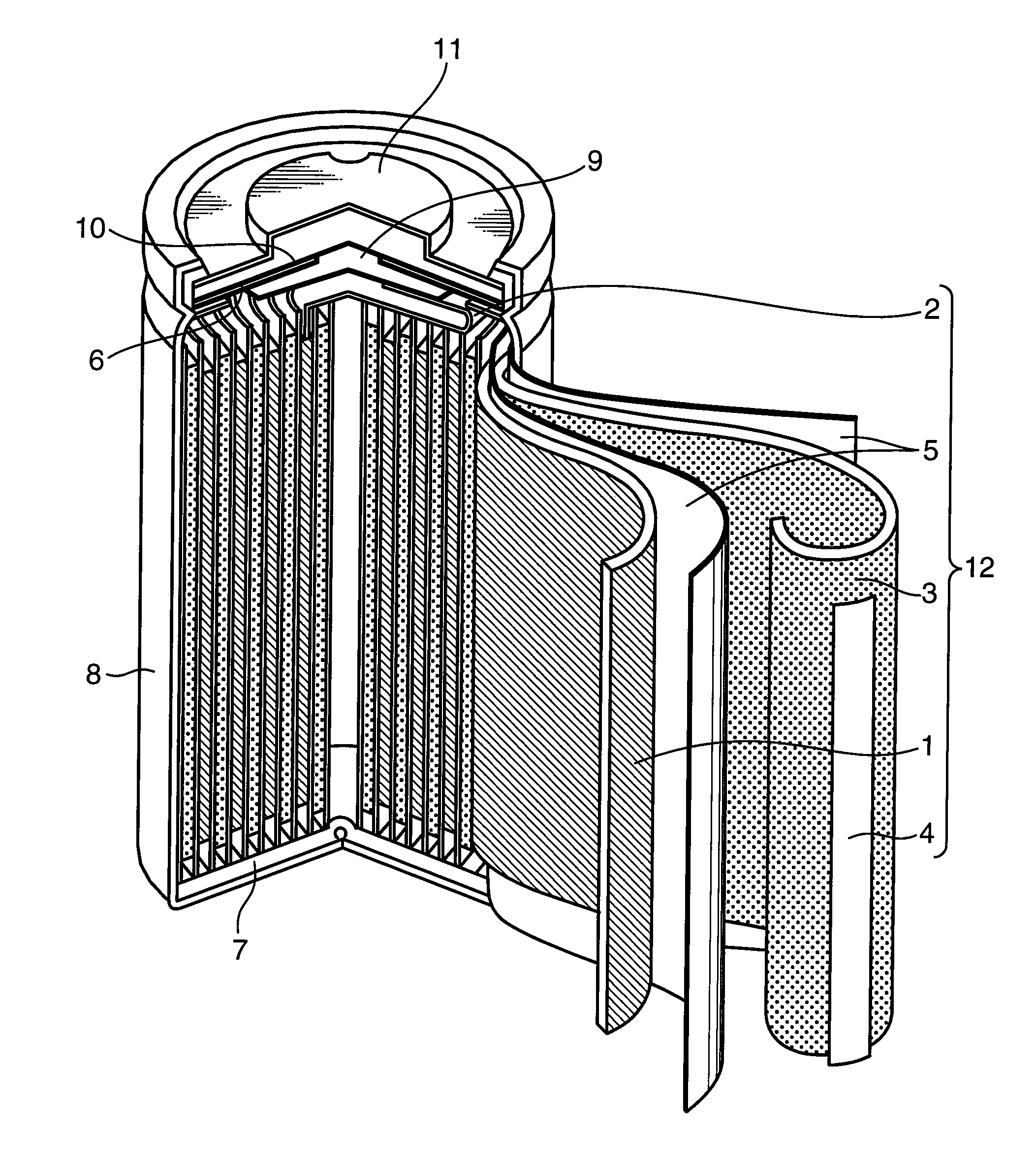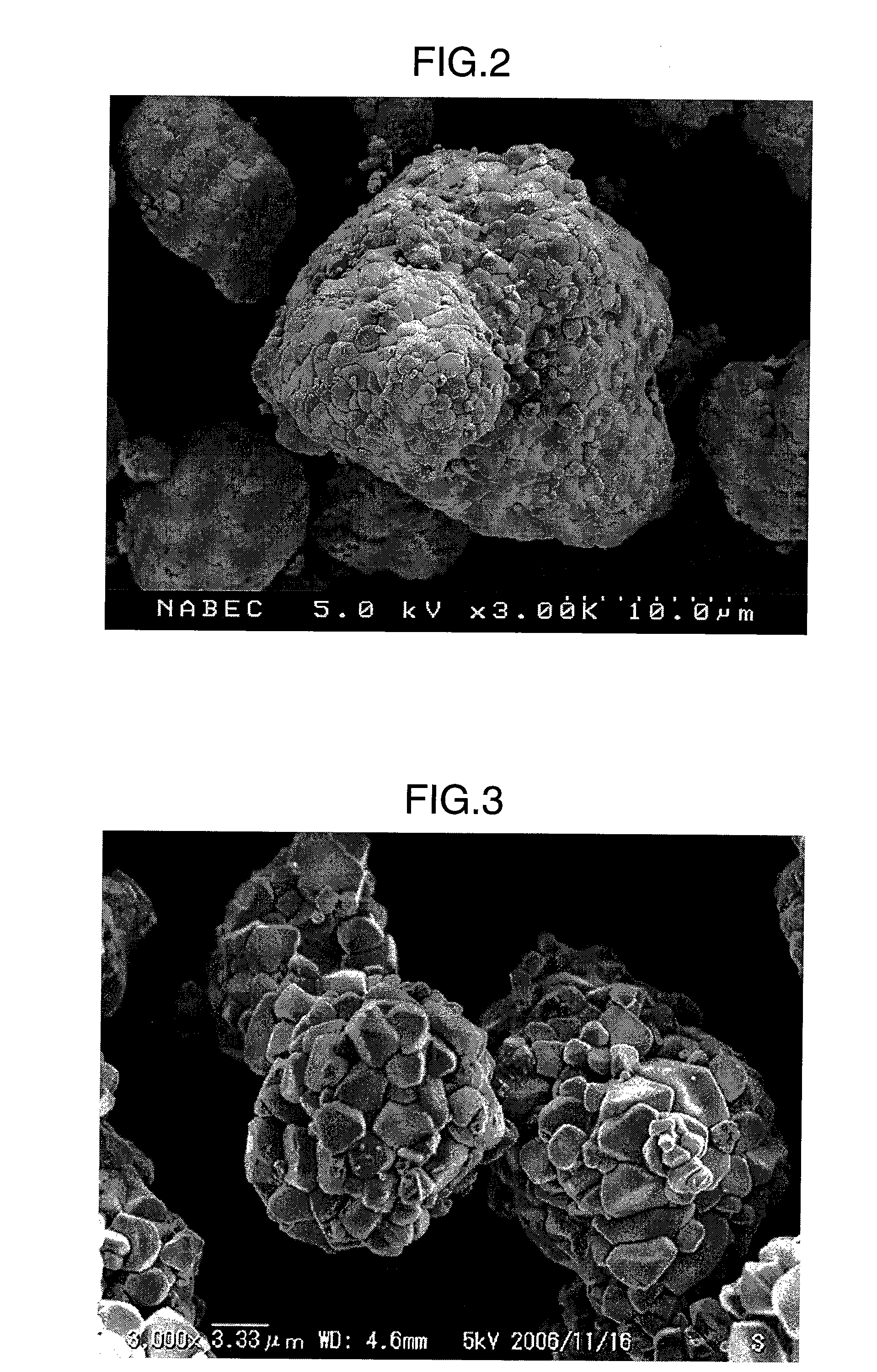Positive electrode active material for non-aqueous electrolyte secondary battery and method for producing the same, and non-aqueous electrolyte secondary battery using positive electrode active material
a non-aqueous electrolyte secondary battery and active material technology, applied in the direction of cell components, cell components, cell components, etc., can solve the problems of remarkably decreasing capacity with an increase of the number of charging and discharging cycles, and reducing the charge and discharge capacity. , the effect of excellent lifetime characteristics
- Summary
- Abstract
- Description
- Claims
- Application Information
AI Technical Summary
Benefits of technology
Problems solved by technology
Method used
Image
Examples
example 1
(i) Production of Positive Electrode Plate
[0093]A macrophotograph taken under a scanning electron microscope (SEM) of NiO (the average particle size of secondary particles is about 15 μm) manufactured by Kanto Chemical Co., Inc. is shown in FIG. 2. FIG. 2 is a macrophotograph at 3,000 times magnification.
[0094]To 3.738 g (50 mmol) of NiO, 0.525 equivalents of Na2O2 was added, followed by sufficient mixing in an agate mortar. The resulting mixture was reacted in an oxygen atmosphere at 650° C. for 12 hours to obtain NaNiO2 whose primary particles have an average particle size of about 5 μm as a nickel-sodium-containing composite positive electrode active material A having an average particle size of about 5 μm, which exist in a state where substantially secondary particles are not formed, were observed. From the macrophotograph shown in FIG. 6, it was confirmed that cracks having a width of several to several tens of nanometers exist densely on the surface of the particles.
[0095]85 p...
example 2
[0100]Equivalent amounts of Ni(OH)2 and Mn2O3 were mixed and then properly mixed and ground using a wet ball mill. The resulting ground mixture was reacted under an oxygen atmosphere at 700° C. for 12 hours to obtain NiMnO3 whose secondary particles have an average particle size of 5 μm.
[0101]In the same manner as in Example 1, except that the resulting NiMnO3 was used in place of NiO, NaNi0.5Mn0.5O2 whose primary particles have an average particle size of 3 μm as a nickel-sodium-containing composite oxide was obtained. In the same manner as in Example 1, except that NaNi0.5Mn0.5O2 was used in place of NaNiO2, a positive electrode active material B made of a nickel-lithium-containing composite oxide was obtained.
[0102]The positive electrode active material B specified by ICP analysis had a composition of Li0.99Na0.01Ni0.5Mn0.5O2. A macrophotograph taken under SEM of the positive electrode active material B was observed. As a result, particles converted into primary particles having ...
example 3
[0104]To a mixed sulfuric acid solution prepared by dissolving 0.3337 mol / L of NiSO4.6H2O and 0.667 mol / L of MnSO4.5H2O, a 1M LiOH.H2O solution was added dropwise to obtain a coprecipitate. The coprecipitate was filtered, dried, ground and then classified to obtain a manganese nickel composite hydroxide whose secondary particles have an average particle size of 10 μm. To the manganese nickel composite hydroxide, 0.6 equivalents of Na2O2 was added, followed by sufficient mixing in an agate mortar. The resulting mixture was reacted under an oxygen atmosphere at 620° C. for 12 hours to obtain a nickel-sodium-containing composite oxide NaNi0.33Mn0.67O2, primary particles of which have an average particle size of 2 μm.
[0105]Then, the resulting NaNi0.33Mn0.67O2 was added in LiNO3 melted at 400° C., followed by a reaction in a dry air atmosphere at a dew point of −40° C. for 3 hours. At this time, the amount of LiNO3 was 10 equivalents based on NaNi0.33Mn0.67O2. The reaction product was co...
PUM
| Property | Measurement | Unit |
|---|---|---|
| particle size | aaaaa | aaaaa |
| temperature | aaaaa | aaaaa |
| particle size | aaaaa | aaaaa |
Abstract
Description
Claims
Application Information
 Login to View More
Login to View More - R&D
- Intellectual Property
- Life Sciences
- Materials
- Tech Scout
- Unparalleled Data Quality
- Higher Quality Content
- 60% Fewer Hallucinations
Browse by: Latest US Patents, China's latest patents, Technical Efficacy Thesaurus, Application Domain, Technology Topic, Popular Technical Reports.
© 2025 PatSnap. All rights reserved.Legal|Privacy policy|Modern Slavery Act Transparency Statement|Sitemap|About US| Contact US: help@patsnap.com



